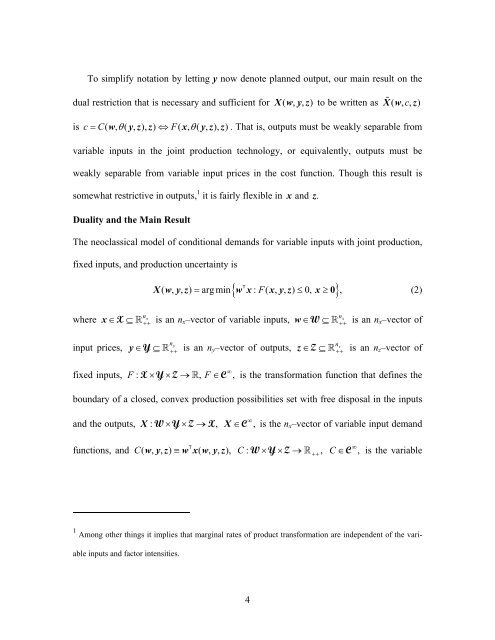Duality Theory for Variable Costs in Joint Production* - ResearchGate
Duality Theory for Variable Costs in Joint Production* - ResearchGate
Duality Theory for Variable Costs in Joint Production* - ResearchGate
You also want an ePaper? Increase the reach of your titles
YUMPU automatically turns print PDFs into web optimized ePapers that Google loves.
To simplify notation by lett<strong>in</strong>g y now denote planned output, our ma<strong>in</strong> result on the<br />
dual restriction that is necessary and sufficient <strong>for</strong> X ( wyz , , ) to be written as X<br />
( w, c, z)<br />
is c = C( w, θ ( y, z), z) ⇔ F( x, θ ( y, z), z ). That is, outputs must be weakly separable from<br />
variable <strong>in</strong>puts <strong>in</strong> the jo<strong>in</strong>t production technology, or equivalently, outputs must be<br />
weakly separable from variable <strong>in</strong>put prices <strong>in</strong> the cost function. Though this result is<br />
somewhat restrictive <strong>in</strong> outputs, 1 it is fairly flexible <strong>in</strong> x and z .<br />
<strong>Duality</strong> and the Ma<strong>in</strong> Result<br />
The neoclassical model of conditional demands <strong>for</strong> variable <strong>in</strong>puts with jo<strong>in</strong>t production,<br />
fixed <strong>in</strong>puts, and production uncerta<strong>in</strong>ty is<br />
{ F<br />
}<br />
T<br />
X( w, y, z) = argm<strong>in</strong> w x: ( x, y, z) ≤0, x ≥0<br />
,<br />
(2)<br />
where<br />
x ∈<br />
⊆<br />
n<br />
++<br />
x<br />
x<br />
X is an n x –vector of variable <strong>in</strong>puts, <br />
n<br />
++<br />
w ∈W ⊆ is an n x –vector of<br />
<strong>in</strong>put prices,<br />
y ∈<br />
n<br />
++<br />
y<br />
z<br />
Y ⊆<br />
is an n y –vector of outputs,<br />
n<br />
++<br />
z ∈Z ⊆<br />
is an n z –vector of<br />
∞<br />
fixed <strong>in</strong>puts, F : X× Y× Z →, F∈C , is the trans<strong>for</strong>mation function that def<strong>in</strong>es the<br />
boundary of a closed, convex production possibilities set with free disposal <strong>in</strong> the <strong>in</strong>puts<br />
and the outputs, X : W × Y × Z →X , X ∈C , is the n x –vector of variable <strong>in</strong>put demand<br />
∞<br />
functions, and C( w, y, z) ≡ w T<br />
x( w, y, z),<br />
: W× Y× Z → , C ∈C , is the variable<br />
C ++<br />
∞<br />
1 Among other th<strong>in</strong>gs it implies that marg<strong>in</strong>al rates of product trans<strong>for</strong>mation are <strong>in</strong>dependent of the variable<br />
<strong>in</strong>puts and factor <strong>in</strong>tensities.<br />
4

















